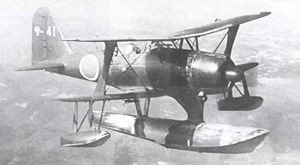- Mitsubishi F1M
-
F1M Mitsubishi F1M2 on patrol, c. 1943 Role Reconnaissance float plane Manufacturer Mitsubishi First flight June 1936 Introduction 1941 Primary user Imperial Japanese Navy Number built 1,118 The Mitsubishi F1M (Allied reporting name "Pete") was a Japanese reconnaissance floatplane of World War II. It was the last biplane type of the Imperial Japanese Navy, with 1,118 built between 1936 and 1944. The Navy designation was "Type Zero Observation Seaplane" (零式水上観測機), not to be confused with the Type Zero Carrier Fighter or the Type Zero Reconnaissance Seaplane.
Contents
Design and development
The F1M1 was powered by the Nakajima Hikari MK1 radial engine, delivering 611 kW (820 hp), a maximum speed of 368 km/h (230 mph) and operating range of up to 1,072 km (670 mi) (when overloaded). It provided the Imperial Japanese Navy with a very versatile operations platform.
Optionally armed with a maximum of three 7.7 mm (.303 in) machine guns (two fixed forward-firing and one flexible rear-firing) and two 60 kg (132 lb) bombs
Operational history
The F1M was originally built as a catapult-launched reconnaissance float plane, specializing in gunnery spotting. However the "Pete" took on a number of local roles including area-defense fighter, convoy escort, bomber, anti-submarine, maritime patrol, rescue and transport. The type fought dogfights in the Aleutians, the Solomons and several other theaters. See also PT 34 sunk 9 April 1942 by "Petes".
Variants
- F1M1 : Prototypes. Four built.
- F1M2 : Two-seat reconnaissance floatplane for the Imperial Japanese Navy.
- F1M2-K : Two-seat training version.
Operators
 Personnel of 80 Squadron RAF amongst parts of a Japanese F1M, bearing Indonesian markings, at an airfield and seaplane base in Surabaya, Java. January 1946
Personnel of 80 Squadron RAF amongst parts of a Japanese F1M, bearing Indonesian markings, at an airfield and seaplane base in Surabaya, Java. January 1946
Specifications (F1M2)
Data from Japanese Aircraft of the Pacific War [1]
General characteristics
- Crew: two, pilot and rear gunner
- Length: 9.5 m (31 ft 2 in)
- Wingspan: 11 m (36 ft 1 in)
- Height: 4 m (13 ft 1½ in)
- Wing area: 29.5 m² (318 ft²)
- Empty weight: 1,928 kg (4,251 lb)
- Loaded weight: 2,550 kg (5,622 lb)
- Max takeoff weight: 2,856 kg[2] (6,296 lb)
- Powerplant: 1 × Mitsubishi Zuisei 13 14-cylinder two-row radial engine, 653 kW (875 hp)
Performance
- Maximum speed: 370 km/h (200 kn, 230 mph) at 3,440 m (11,300 ft)
- Range: 740 km (400 nmi, 460 mi)
- Service ceiling: 9,440 m (30,970 ft)
- Wing loading: 86.3 kg/m² (17.7 lb/ft²)
- Power/mass: 2.9 kW/kg (6.85 hp/lb)
- Climb to 5,000 m (16,404 ft): 9 min 36 sec
Armament
- Guns:
- 2 × fixed forward-firing 7.7 mm (.303 in) Type 97 machine guns
- 1 × flexible rearward-firing 7.7 mm (.303 in) Type 92 machine gun
- Bombs: 2 × 60 kg (132 lb) bombs
Gallery
See also
- Aircraft of comparable role, configuration and era
- Related lists
References
Notes
Bibliography
- Francillon, R.J. Japanese Aircraft of the Pacific War. London:Putnam, 1970. ISBN 370 00033 1.
- Green, William. War Planes of the Second World War, Volume Six: Floatplanes. London: Macdonald & Co., (Publishers) Ltd., 1962.
Aircraft produced by Mitsubishi Aircraft Company, Mitsubishi Heavy Industries,
and Mitsubishi Aircraft CorporationCompany designations Imperial Japanese Army short designations Imperial Japanese Navy short designations Japanese Self-Defense Force designations World War II Allied reporting names Japanese Navy Observation Seaplane designations F1A/F1K/F1MWorld War II Allied reporting names for Japanese aircraft Aircraft in Japanese service Abdul • Alf • Ann • Babs • Baka • Belle • Betty • Bob • Buzzard • Cedar • Cherry • Clara • Claude • Cypress • Dave • Dick • Dinah • Dot • Edna • Emily • Eva • Eve • Frances • Frank • Gander • George • Glen • Goose • Grace • Gwen • Hamp • Hank • Hap • Helen • Hickory • Ida (Tachikawa Ki-36) • Ida (Tachikawa Ki-55) • Irving • Jack • Jake • Jane • Jean • Jerry • Jill • Jim • Judy • Kate • Kate 61 • Laura • Lily • Liz • Lorna • Loise • Louise • Luke • Mabel • Mary • Mavis • Myrt • Nate • Nell • Nick • Norm • Oak • Oscar • Pat • Patsy • Paul • Peggy • Perry • Pete • Pine • Rex • Rita • Rob • Rufe • Ruth • Sally • Sally III • Sam • Sandy • Slim • Sonia • Spruce • Stella • Steve • Susie • Tabby • Tess • Thalia • Thelma • Theresa • Thora • Tina • Tillie • Toby • Tojo • Tony • Topsy • Val • Willow • Zeke • Zeke 32
Nonexistent aircraft thought to be in Japanese service Adam • Ben • Doris • Gus • Harry • Ione • Joe • Joyce • Julia • June • Norma • Omar • Ray
Foreign aircraft erroneously thought to be in Japanese service Lists relating to aviation General Aircraft (manufacturers) · Aircraft engines (manufacturers) · Airlines (defunct) · Airports · Civil authorities · Museums · Registration prefixes · Rotorcraft (manufacturers) · TimelineMilitary Accidents/incidents Records Categories:- Japanese military reconnaissance aircraft 1930–1939
- Seaplanes and flying boats
- World War II Japanese reconnaissance aircraft
- Mitsubishi aircraft
Wikimedia Foundation. 2010.





